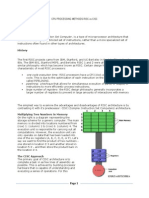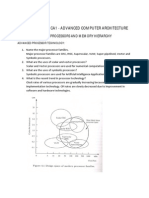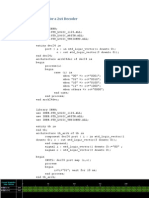Design of 32-Bit Risc Cpu Based On Mips: Journal of Global Research in Computer Science
Design of 32-Bit Risc Cpu Based On Mips: Journal of Global Research in Computer Science
Uploaded by
Akanksha Dixit ManodhyaCopyright:
Available Formats
Design of 32-Bit Risc Cpu Based On Mips: Journal of Global Research in Computer Science
Design of 32-Bit Risc Cpu Based On Mips: Journal of Global Research in Computer Science
Uploaded by
Akanksha Dixit ManodhyaOriginal Title
Copyright
Available Formats
Share this document
Did you find this document useful?
Is this content inappropriate?
Copyright:
Available Formats
Design of 32-Bit Risc Cpu Based On Mips: Journal of Global Research in Computer Science
Design of 32-Bit Risc Cpu Based On Mips: Journal of Global Research in Computer Science
Uploaded by
Akanksha Dixit ManodhyaCopyright:
Available Formats
Volume 2, No.
9, September 2011
Journal of Global Research in Computer Science
RESEARCH PAPER
Available Online at www.jgrcs.info
JGRCS 2010, All Rights Reserved 20
DESIGN OF 32-BIT RISC CPU BASED ON MIPS
N.Alekya*
1
,P.Ganesh Kumar
2
1
Department of ECE, Kakinada Institute of Engineering & Technology, Kakinada, AP, INDIA
alekhya.nakka@gmail.com
1
2
Assistant Professor ,Department of ECE, Kakinada Institute of Engineering & Technology, Kakinada, AP, INDIA
Abstract: The main aim of the project is simulation and synthesis of the 32-bit RISC CPU based on MIPS. The project involves design of a
simple RISC processor and simulating it. A Reduced Instruction Set compiler (RISC) is a microprocessor that had been designed to perform a
small set of instructions, with the aim of increasing the overall speed of the processor . In this work, we analyze MIPS instruction format,
instruction data path, decoder module function and design theory based on RISC (Reduced Instruction Set Computer) CPU instruction set.
Furthermore, we use pipeline design process to simulate successfully, which involves instruction fetch (IF), instruction decoder (ID), execution
(EXE), data memory (MEM), write back (WB) modules of 32-bit CPU based on RISC CPU instruction set. Function of IF module is fetches the
instruction from memory. The function of ID stage is sends control commands i.e., instructions are sending to control unit and decoded here. The
EXE stage executes arithmetic. Main component of the EXE stage is ALU. The MEM stage is to fetch data from memory and store data to
memory, if instruction is not memory/IO instruction, result is sent to WB stage. At last WB stage charges of writing the results, stores data and
input data to register file. The purpose of WB stage is to write data to destination register. The idea of this project was to create a RISC processor
as a building block in VHDL than later easily can be included in a larger design. It will be useful in systems where a problem is easy to solve in
software but hard to solve with control logic. However at a high level of complexity it is easier to implement the function i n software. In this
project for simulation we use Modelsim for logical verification, and further synthesizing it on Xilinx-ISE tool using target technology and
performing placing & routing operation for system verification. The language we used here is VHDL, and tools required here are MODELSIM
III SE 6.4b Simulation XILINX-ISE 10.1 Synthesis. The applications are automatic robot control, bottling plant.
Keywords: RISC, MIPS,Simulation Synthesis ,Instruction Set,MODELSIM.s
INTRODUCTION
Risc Mips Features:
Processors are much faster than memories. For example, a
processor clocked at 100 MHz would like to access memory
in 10 nanoseconds, the period of its 100 MHz clock.
Unfortunately, the memory interfaced to the processor might
require 60 nanoseconds for an access. So, the processor
ends up waiting during each memory access, wasting
execution cycles.
To reduce the number of accesses to main memory,
designers added instruction and data cache to the processors.
A cache is a special type of high speed RAM where data and
the address of the data are stored. Whenever the processor
tries to read data from main memory, the cache is examined
first. If one of the addresses stored in the cache matches the
address being used for the memory read (called a hit), the
cache will supply the data instead. Cache is commonly ten
times faster than main memory, so you can see the
advantage of getting data in 10 nanoseconds instead of 60
nanoseconds. Only when we miss (i.e., do not find the
required data in the cache), does it take the full access time
of 60 nanoseconds. But this can only happen once. Since a
copy of the new data is written into the cache after a miss.
The data will be there the next time we need it. Instruction
cache is used to store frequently used instructions. Data
cache is used to store frequently used data. Implementing
fewer instructions and addressing modes on silicon reduces
the complexity of the instruction decoder, the addressing
logic, and the execution unit. This allows the machine to be
clocked at a faster speed, since less work needs to be done
each clock period.
RISC typically has large set of registers. The number of
registers available in a processor can affect performance the
same way a memory access does. A complex calculation
may require the use of several data values. If the data values
all reside in memory during the calculations, many memory
accesses must be used to utilize them. If the data values are
stored in the internal registers of the processor instead, their
access during calculations will be much faster. It is good
then to have lot of internal registers.
PREVIOUS WORK
The MIPS single-cycle processor performs the tasks of
instruction fetch, instruction decode, execution, memory
access and write-back all in one clock cycle. First the PC
value is used as an address to index the instruction memory
which supplies a 32-bit value of the next instruction to be
executed. This instruction is then divided into the different
fields shown in Table 2.1. The instructions opcode field bits
[31-26] are sent to a control unit to determine the type of
instruction to execute. The type of instruction then
determines which control signals are to be asserted and what
function the ALU is to perform, thus decoding the
instruction. The instruction register address fields $rs bits
[25 - 21], $rt bits [20 - 16], and $rd bits [15-11] are used to
address the register file. The register file supports two
independent register reads and one register write in one
clock cycle. The register file reads in the requested
addresses and outputs the data values contained in these
registers. These data values can then be operated on by the
ALU whose operation is determined by the control unit to
either compute a memory address (e.g. load or store),
compute an arithmetic result (e.g. add, and or slt), or
perform a compare (e.g. branch). If the instruction decoded
N.Alekya et al, Journal of Global Research in Computer Science,2 (9), September 2011, 20-24
JGRCS 2011, All Rights Reserved 21
is arithmetic, the ALU result must be written to a register. If
the instruction decoded is a load or a store, the ALU result is
then used to address the data memory. The final step writes
the ALU result or memory value back to the register file.
Figure 1. MIPS Single-cycle Processor
SYSTEM OVERVIEW
Mips Pipelined Processor Vhdl Implementation:
Once the MIPS single-cycle VHDL implementation was
completed, our next task was to pipeline the MIPS
processor. Pipelining, a standard feature in RISC processors,
is a technique used to improve both clock speed and overall
performance. Pipelining allows a processor to work on
different steps of the instruction at the same time, thus more
instruction can be executed in a shorter period of time. For
example in the VHDL MIPS single-cycle implementation
above, the datapath is divided into different modules, where
each module must wait for the previous one to finish before
it can execute, thereby completing one instruction in one
long clock cycle. When the MIPS processor is pipelined,
during a single clock cycle each one of those modules or
stages is in use at exactly the same time executing on
different instructions in parallel. Figure 2 shows an example
of a MIPS single-cycle non-pipelined (a.) versus a MIPS
pipelined implementation (b.). The pipelined
implementation executes faster, keep in mind that both
implementations use the same hardware components.
Figure 2. Single-cycle non-pipelined (a) vs. pipelined execution (b)
The MIPS pipelined processor involves five steps; the
division of an instruction into five stages implies a five-
stage pipeline:
a. Instruction Fetch (IF): fetching the instruction from
the memory
b. Instruction Decode (ID): reading the registers and
decoding the instruction
c. Execution (EX): executing an operation or
calculating an address
d. Data Memory (MEM): accessing the data memory
e. Write Back (WB): writing the result into a register.
The key to pipelining the single-cycle implementation of the
MIPS processor is the introduction of pipeline registers that
are used to separate the datapath into the five sections IF,
ID, EX, MEM and WB. Pipeline registers are used to store
the values used by an instruction as it proceeds through the
subsequent stages. The MIPS pipelined registers are labeled
according to the stages they separate. (e.g. IF/ID, ID/EX,
EX/MEM, MEM/WB) Figure 3 shows and example of a
pipelined datapath excluding the control unit and control
signal lines.
N.Alekya et al, Journal of Global Research in Computer Science,2 (9), September 2011, 20-24
JGRCS 2011, All Rights Reserved 22
Figure 3. MIPS Pipelined Processor Datapath
To implement the MIPS pipelined processor, pipeline
registers are placed into the corresponding VHDL modules
that generate the input to the particular pipeline register. For
example, the Instruction Fetch component will generate the
32-bit instruction and the PC+4 value and store them into
the IF/ID pipeline register. When that instruction moves to
the Instruction Decode stages it extracts those saved values
from the IF/ID pipeline register. Appendix F contains the
complete VHDL code used to implement the MIPS
pipelined processor data path. Appendices G shows an
example of MIPS processor pipelined being simulated.
DESIGN & IMPLEMENTATION
I ntroducti on to Model Simul ator:
Project Flow: A project is a collection mechanism for an
HDL design under specification or test. Even though you
dont have to use projects in ModelSim, they may ease
interaction with the tool and are useful for organizing files
and specifying simulation settings. The following diagram
shows the basic steps for simulating a design within a
ModelSim project.
Figure 4. Project design flow
As you can see, the flow is similar to the basic simulation
flow. However, there are two important differences:
You do not have to create a working library in the project
flow; it is done for you automatically. Projects are
persistent. In other words, they will open every time you
invoke ModelSimunless you specifically close them.
Design Files for this Lesson: The sample design for this
lesson is a simple 8-bit, binary up-counter with an
associated testbench. The pathnames are as follows:
Verilog:
<install_dir>/examples/tutorials/verilog/basicSimulation/co
unter.v and tcounter.v
VHDL:
<install_dir>/examples/tutorials/vhdl/basicSimulation/coun
ter.vhd and tcounter.vhd
This lesson uses the Verilog files counter.v and tcounter.v.
If you have a VHDL license, use counter.vhd and
tcounter.vhd instead. Or, if you have a mixed license, feel
free to use the Verilog testbench with the VHDL counter or
vice versa.
Create the Working Design Library: Before you can
simulate a design, you must first create a library and
compile the source code into that library.
1. Create a new directory and copy the design files for this
lesson into it.
Start by creating a new directory for this exercise (in case
other users will be working with these lessons).
Verilog: Copy counter.v and tcounter.v files from
/<install_dir>/examples/tutorials/verilog/basicSimulation to
the new directory.
VHDL: Copy counter.vhd and tcounter.vhd files from
/<install_dir>/examples/tutorials/vhdl/basicSimulation to
the new directory.
2. Start ModelSim if necessary.
a. Type vsim at a UNIX shell prompt or use the ModelSim
icon in Windows. Upon opening ModelSim for the first
time, you will see the Welcome to ModelSim dialog. Click
Close.
b. Select File > Change Directory and change to the
directory you created in step 1.
3. Create the working library.
a. Select File > New > Library.
This opens a dialog where you specify physical and logical
names for the library (Figure 5). You can create a new
library or map to an existing library. Well be doing the
former.
Run the Simulation:
Now you will open the Wave window, add signals to it, then
run the simulation.
1. Open the Wave debugging window.
a. Enter view wave at the command line
You can also use the View > Wave menu selection to open
a Wave window.
The Wave window is one of several windows available for
debugging. To see a list of the other debugging windows,
select the View menu. You may need to move or resize the
windows to your liking. Window panes within the Main
window can be zoomed to occupy the entire Main window
N.Alekya et al, Journal of Global Research in Computer Science,2 (9), September 2011, 20-24
JGRCS 2011, All Rights Reserved 23
or undocked to stand alone. For details, see Navigating the
Interface.
2. Add signals to the Wave window.
a. In the Workspace pane, select the sim tab.
b. Right-click test_counter to open a popup context menu.
c. Select Add > To Wave > All items in region (Figure 5).
All signals in the design are added to the Wave window.
Figure 5. Using the Popup Menu to Add Signals to Wave Window
3. Run the simulation.
a. Click the Run icon in the Main or Wave window toolbar.
The simulation runs for 100 ns (the default simulation
length) and waves are drawn in the Wave window.
b. Enter run 500 at the VSIM> prompt in the Main window.
The simulation advances another 500 ns for a total of 600 ns
(Figure 6).
Figure 6. Waves Drawn in Wave Window
c. Click the Run -All icon on the Main or Wave window
toolbar.The simulation continues running until you execute
a break command or it hits a statement in your code
(e.g., a Verilog $stop statement) that halts the simulation.
d. Click the Break icon. The simulation stops running.
RESULTS
Simulation Results:
The work presented in this Thesis describes a functional
FPGA implementation design of a MIPS single-cycle and
pipelined processor designed using VHDL. The VHDL
designs of the MIPS processor were all simulated to ensure
that the processors were functional and operated just as
described by Patterson and Hennessy. The results show first
the instruction memory initialization, which is used to fill
the instruction memory with the instructions to be executed,
which are indexed by the program counter (PC). The second
is the actual 32-bit instruction represented using
hexadecimal numbers. The third is the PC value used to
index the instruction memory to retrieve an instruction. The
next four columns are the MIPS instructions mnemonic
description. Finally last columns are the pseudo instructions
using the actual values used during the simulation.
Figure 7. Result of simulation
Synthesis Result:
The developed convolution project is simulated and verified
their functionality. Once the functional verification is done,
the RTL model is taken to the synthesis process using the
Xilinx ISE tool. In synthesis process, the RTL model will be
converted to the gate level net-list mapped to a specific
technology library. Here in this Spartan 3E family, many
different devices were available in the Xilinx ISE tool. The
target device is SPARTAN 2 FPGA kit. In order to
synthesis this design the device named as XC3S100E has
been chosen and the package as TQ144 with the device
speed such as 5.
RTL Schematic:
The RTL (Register Transfer Logic) can be viewed as black
box after synthesize of design is made. It shows the inputs
and outputs of the system. By double-clicking on the
diagram we can see gates, flip-flops and MUX.
N.Alekya et al, Journal of Global Research in Computer Science,2 (9), September 2011, 20-24
JGRCS 2011, All Rights Reserved 24
Figure 8. RTL Schematic internal view
The above figure 8. Shows the top level block diagram that
contains the primary inputs and outputs of the design.
Device Utilization Summary:
This device utilization includes the following.
a. Logic Utilization
b. Logic Distribution
c. Total Gate count for the Design
Figure 9. Summary for the Device utilization time
The device utilization summery is shown above in which its
gives the details of number of devices used from the
available devices and also represented in %. Hence as the
result of the synthesis process, the device utilization in the
used device and package is shown above.
Timing Summary:
Speed Grade: -3 Minimum period: 3.203ns (Maximum
Frequency: 312.173MHz) Minimum input arrival time
before clock: 145.587ns Maximum output required time
after clock: 6.156ns Maximum combinational path delay:
6.662ns
In timing summery, details regarding time period and
frequency is shown are approximate while synthesize. After
place and routing is over, we get the exact timing summery.
Hence the maximum operating frequency of this synthesized
design is given as 18.970 MHz and the minimum period as
52.719 ns. OFFSET IN is the minimum input arrival time
before clock and OFFSET OUT is maximum output
required time after clock.
CONCLUSIONS
In this project it is observed that the RISC MIPS based
system is simulated using VHDL. The overall system is
simulated and synthesized, after synthesizing the system we
could get a statistical data about the number of input-output
buffers, the number of registers, number of flip-flops and
latches were used in the usage of FPGA tool. The modules
simulated are Accumulator, Buffer, Clock Generator,
Instruction Register, Multiplexer, Program Counter, Reset,
Control Logic Decoder, Arithmetic Logic Unit and the
overall system. Few instructions were executed and their
timing sequences were analyzed. It is found that an each
instruction taken 100ps.It shows that the different operations
of the instruction including the decoding and execution
comes to 40ns in the overall system. Therefore we conclude
that the behavior shows, the system is working as RISC as
instruction will be executed within a single clock cycle.
REFERENCES
[1]. Bai-ZhongYing, Computer Organization, Science Press,
2000.11.
[2]. Wang-AiYing, Organization and Structure of Computer,
Tsinghua University Press, 2006.
[3]. Wang-YuanZhen, IBM-PC Macro Asm Program, Huazhong
University of Science and Technology Press, 1996.9.
[4]. MIPS Technologies, Inc. MIPS32 Architecture For
ProgrammersVolume II: The MIPS32 Instruction
SetJune 9, 2003.
[5]. Zheng-WeiMin, Tang-ZhiZhong. Computer System
Structure (The second edition), Tsinghua University Press,
2006.
[6]. Pan-Song, Huang-JiYe, SOPC Technology Utility Tutorial,
Tsinghua University Press, 2006.
[7]. MIPS32 4KTMProcessor Core Family Software User's
Manual, MIPS Technologies Inc.
[8]. Mo-JianKun, Gao-JianSheng,Computer Organization,
Huazhong University of Science and Technology Press,
1996.
[9]. Zhang-XiuJuan, Chen-XinHua, EDA Design and emulation
Practice [M]. BeiJing, Engine Industry Press. 2003.
[10]. "IEEE Standard of Binary Floating-Point Arithmetic" IEEE
Standard754, IEEE Computer Society, 1985.
[11]. Yi-Kui, Ding-YueHua, Application of AMCCS5933
Controller in PCI BUS, DCABES2007, 20077.
You might also like
- Computer Architecture Question PaperDocument14 pagesComputer Architecture Question Paperheaughfrds100% (1)
- CA 2mark and 16 Mark With AnswerDocument112 pagesCA 2mark and 16 Mark With AnswerOmprakash DNo ratings yet
- Jan Marie Veatrice M. Pacia 4-ECE: What Are Cisc and Risc Architecture? How Do They Differ From Each Other?Document6 pagesJan Marie Veatrice M. Pacia 4-ECE: What Are Cisc and Risc Architecture? How Do They Differ From Each Other?Jan Marie Veatrice PaciaNo ratings yet
- Processor Types: RISC Processor RISC Stands For Reduced Instruction SetDocument9 pagesProcessor Types: RISC Processor RISC Stands For Reduced Instruction SetDebashish RoyNo ratings yet
- Reduced Instruction Set Computing (RISC) : Li-Chuan FangDocument42 pagesReduced Instruction Set Computing (RISC) : Li-Chuan FangDevang PatelNo ratings yet
- 7807_et_ETDocument10 pages7807_et_ETmnh2024iliNo ratings yet
- Input Unit: Five Basic Components of Computer SystemDocument9 pagesInput Unit: Five Basic Components of Computer SystemJefin PaulNo ratings yet
- CA Classes-106-110Document5 pagesCA Classes-106-110SrinivasaRaoNo ratings yet
- RISC Vs CISCDocument7 pagesRISC Vs CISCAlfred LunsinNo ratings yet
- Computer Architecture 2 MarksDocument32 pagesComputer Architecture 2 MarksArchanavgs0% (1)
- ASIC Design of MIPS Based RISC Processor For High PerformanceDocument7 pagesASIC Design of MIPS Based RISC Processor For High PerformanceShrinidhi RaoNo ratings yet
- COA Unit-5Document144 pagesCOA Unit-5varshiniveeramalla07No ratings yet
- Risc Vs CiscDocument6 pagesRisc Vs CiscMichellePascualPullonNo ratings yet
- The Ultimate OCR A Level Computer Science Dictionary (v5.0)Document30 pagesThe Ultimate OCR A Level Computer Science Dictionary (v5.0)githubtest511No ratings yet
- Computer Architecture Lesson 2 (Instruction Set Architecture)Document9 pagesComputer Architecture Lesson 2 (Instruction Set Architecture)ghassanNo ratings yet
- Risc VDocument4 pagesRisc VOlhaNo ratings yet
- Risc VDocument5 pagesRisc VOlhaNo ratings yet
- Cyan 2800398239029h09fn0ivj0vcjb0Document16 pagesCyan 2800398239029h09fn0ivj0vcjb0Anonymous zWBss8LKNo ratings yet
- Coa Unit - 5 NotesDocument6 pagesCoa Unit - 5 Notes1NT19IS077-MADHURI.CNo ratings yet
- 16 - Bit RISC Processor Design For Convolution Application Using Verilog HDLDocument64 pages16 - Bit RISC Processor Design For Convolution Application Using Verilog HDLchandra sekhar100% (1)
- Lecture 2 Basic CPU ArchitecturesDocument7 pagesLecture 2 Basic CPU ArchitecturesMohan Krishna Reddy KarriNo ratings yet
- Computer Organisation and ArchitectureDocument4 pagesComputer Organisation and Architecturegreat martin96No ratings yet
- Session2 - Introduction To RISC and CISCDocument4 pagesSession2 - Introduction To RISC and CISCHillary MurungaNo ratings yet
- The Simplest Way To Examine The Advantages and Disadvantages of RISC Architecture Is by Contrasting It With ItDocument11 pagesThe Simplest Way To Examine The Advantages and Disadvantages of RISC Architecture Is by Contrasting It With ItsaadawarNo ratings yet
- Reduced Instruction Set Computer (RISC) : Presented ToDocument11 pagesReduced Instruction Set Computer (RISC) : Presented ToAmrNo ratings yet
- Computer ArchitectureDocument125 pagesComputer Architecturebalaji bala100% (1)
- Project-1 Basic Architecture DesignDocument4 pagesProject-1 Basic Architecture DesignUmesh KumarNo ratings yet
- Lecture 18 - RICS and CISC PropertiesDocument8 pagesLecture 18 - RICS and CISC PropertiesPragya SinghNo ratings yet
- P11Mca1 & P8Mca1 - Advanced Computer Architecture: Unit V Processors and Memory HierarchyDocument45 pagesP11Mca1 & P8Mca1 - Advanced Computer Architecture: Unit V Processors and Memory HierarchyMohanty AyodhyaNo ratings yet
- Advanced Computer Architecture 1 1Document118 pagesAdvanced Computer Architecture 1 1SharathMenonNo ratings yet
- CA 2mark and 16 Mark With AnswerDocument109 pagesCA 2mark and 16 Mark With AnswerJagadeesh Mohan100% (1)
- MICROPROCESSORSDocument10 pagesMICROPROCESSORSKELVIN MUTHININo ratings yet
- Notes 1Document62 pagesNotes 1dragonslayeranishNo ratings yet
- MIPS Report FileDocument17 pagesMIPS Report FileAayushiNo ratings yet
- Microcoded ArchDocument12 pagesMicrocoded ArchAnonymous pHi4dXNo ratings yet
- 17 Bit Implementation For Dual Core Risc ArchitectureDocument6 pages17 Bit Implementation For Dual Core Risc ArchitecturelambanaveenNo ratings yet
- Computer ArchiDocument58 pagesComputer ArchiJebun Naher JuthyNo ratings yet
- ANSWERS 1 Microprocessor & Assembly Language Programming Year 3 Semester IIDocument17 pagesANSWERS 1 Microprocessor & Assembly Language Programming Year 3 Semester IIJoseph Njenga MumasihiNo ratings yet
- 2 16 1350130228 7. Flexible Wireless DataDocument6 pages2 16 1350130228 7. Flexible Wireless DataSumeet SauravNo ratings yet
- HCSE 213 What Is A MicroprocessorDocument5 pagesHCSE 213 What Is A MicroprocessorObert MutavaNo ratings yet
- Computer System Organization: ProcessorsDocument21 pagesComputer System Organization: Processorsfahadwahid550No ratings yet
- Implementation of 5-Stage 32-Bit Microprocessor Based Without Interlocked Pipelining StagesDocument5 pagesImplementation of 5-Stage 32-Bit Microprocessor Based Without Interlocked Pipelining Stagesashish jhaNo ratings yet
- Design and Implementation of RISC MIPS Processor On FPGADocument7 pagesDesign and Implementation of RISC MIPS Processor On FPGAIJRASETPublicationsNo ratings yet
- Microprocessor 8085&86Document38 pagesMicroprocessor 8085&86anil gaurNo ratings yet
- Computer Architecture Solved Paper 2024Document38 pagesComputer Architecture Solved Paper 2024yashas786reddyNo ratings yet
- BTES-401-18 (05-12-2023) SolutionDocument11 pagesBTES-401-18 (05-12-2023) Solutionuditanshu2605No ratings yet
- Ca Unit 4 PrabuDocument24 pagesCa Unit 4 Prabu6109 Sathish Kumar JNo ratings yet
- DSP Mod 6Document6 pagesDSP Mod 6Aabha KadamNo ratings yet
- AOK Lecture03 PDFDocument28 pagesAOK Lecture03 PDFAndre SetiawanNo ratings yet
- Cisc Vs Risc: Multiplying Two Numbers in MemoryDocument4 pagesCisc Vs Risc: Multiplying Two Numbers in MemoryItz Sami UddinNo ratings yet
- CAM Tutorial 1Document15 pagesCAM Tutorial 1ram010No ratings yet
- Lecture Notes-Computer Architecture-Module 1Document20 pagesLecture Notes-Computer Architecture-Module 1mokshagnanare26No ratings yet
- Design and Application of RISC ProcessorDocument5 pagesDesign and Application of RISC ProcessorM IbrahimNo ratings yet
- 03 Cisc RiscDocument37 pages03 Cisc RiscahmedNo ratings yet
- Smart Parking RobotDocument97 pagesSmart Parking RobotKishan KumarNo ratings yet
- Introduction To Embedded SystemsDocument11 pagesIntroduction To Embedded SystemsNikhith ReddyNo ratings yet
- ISA ModelsDocument5 pagesISA ModelsFahad Tanveer MalikNo ratings yet
- Risc PropertiesDocument2 pagesRisc PropertiesSwetha RamNo ratings yet
- Risc Processor Using VHDLDocument5 pagesRisc Processor Using VHDLAruna RajanNo ratings yet
- Practical Reverse Engineering: x86, x64, ARM, Windows Kernel, Reversing Tools, and ObfuscationFrom EverandPractical Reverse Engineering: x86, x64, ARM, Windows Kernel, Reversing Tools, and ObfuscationNo ratings yet
- 3) Basic - VHDL - ConstructsDocument36 pages3) Basic - VHDL - Constructsfaxofi9132No ratings yet
- Intelligence Engineering and Industrial Automation Research Group, Department of Electrical Engineering and Electronics, The University of Liverpool, Liverpool, L69 3GJ, U.KDocument6 pagesIntelligence Engineering and Industrial Automation Research Group, Department of Electrical Engineering and Electronics, The University of Liverpool, Liverpool, L69 3GJ, U.Khaipro91No ratings yet
- B.Tech - ECE - Study Scheme Syllabus Upto - 8th Sem. 2018 Onwards Updated On 8th - July - 2022Document89 pagesB.Tech - ECE - Study Scheme Syllabus Upto - 8th Sem. 2018 Onwards Updated On 8th - July - 2022Anurag DavesarNo ratings yet
- VHDL CodesDocument8 pagesVHDL Codespooja_2408No ratings yet
- FINAL REPORT CryptographyDocument63 pagesFINAL REPORT CryptographydharadipalNo ratings yet
- Course Plan Mtech 2014 SpringDocument16 pagesCourse Plan Mtech 2014 SpringSubhabrata DasNo ratings yet
- Getting Started With Vivado Design Suite For EDGE Spartan 7 FPGA KitDocument11 pagesGetting Started With Vivado Design Suite For EDGE Spartan 7 FPGA KitVINAY YADAVNo ratings yet
- Virtuoso MmsimDocument12 pagesVirtuoso Mmsim刘航No ratings yet
- Interleaver/ De-Interleaver V8.0: Logicore Ip Product GuideDocument78 pagesInterleaver/ De-Interleaver V8.0: Logicore Ip Product GuideAkhileshAlexGoyalNo ratings yet
- Design and Implementation Ofdm Transmitter and ReceiverDocument54 pagesDesign and Implementation Ofdm Transmitter and Receiverمصطفى محمد عيد سلامة100% (1)
- Saurabh Dargan ResumeDocument3 pagesSaurabh Dargan ResumeArun Kumar ModiNo ratings yet
- Advanced VLSI Design: Homework No.2Document10 pagesAdvanced VLSI Design: Homework No.2Nima AfrazNo ratings yet
- ON "Vlsi - Design": Supervisor: Submitted By: DR Montasar Sharif Mohammed Ayoub OthmanDocument13 pagesON "Vlsi - Design": Supervisor: Submitted By: DR Montasar Sharif Mohammed Ayoub OthmanMahamad AyoubNo ratings yet
- R20 - VLSI Lab ManualDocument64 pagesR20 - VLSI Lab Manualeducational9hubNo ratings yet
- VHDLDocument96 pagesVHDLJeevan Bhat100% (8)
- VHDL MugDocument380 pagesVHDL Mugredoctober24No ratings yet
- PG - Microelectronics & VLSI System DesignDocument35 pagesPG - Microelectronics & VLSI System DesignBhaskar KNo ratings yet
- Assignment 1Document8 pagesAssignment 1phyrdowsNo ratings yet
- Design Entry in VHDL, Entity, ArchitectureDocument32 pagesDesign Entry in VHDL, Entity, ArchitectureSHYAMNo ratings yet
- Federal University of Technology AkureDocument9 pagesFederal University of Technology AkuretarvsNo ratings yet
- FPGA Implementation of Digital Camera Controller and Frame Capture Device in VHDL. by MD Shakir RahmaniDocument13 pagesFPGA Implementation of Digital Camera Controller and Frame Capture Device in VHDL. by MD Shakir RahmaniShakir RahmaniNo ratings yet
- Lab Sequential CircuitsDocument6 pagesLab Sequential CircuitsMu'izz KaharNo ratings yet
- Digital Electronics Unit4 NotesDocument35 pagesDigital Electronics Unit4 Notesyellasuresh15No ratings yet
- Introuction To DSD With VHDLDocument19 pagesIntrouction To DSD With VHDLAssini HussainNo ratings yet
- Experiment 3: BackgroundDocument6 pagesExperiment 3: Backgroundmunib zafarNo ratings yet
- VLSI Lab Manual V Sem July16Document65 pagesVLSI Lab Manual V Sem July16Aditya RanjanNo ratings yet
- ug-730191-819675Document63 pagesug-730191-819675Andre AbreuNo ratings yet
- Comparator 1-BitDocument5 pagesComparator 1-Bitmy.show7777No ratings yet
- סיכום תמציתי של פקודות ותחביר ב-VHDLDocument4 pagesסיכום תמציתי של פקודות ותחביר ב-VHDLRonNo ratings yet
- Logicore Ip Adder/Subtracter v11.0Document10 pagesLogicore Ip Adder/Subtracter v11.0ahmedshah512No ratings yet

























































































